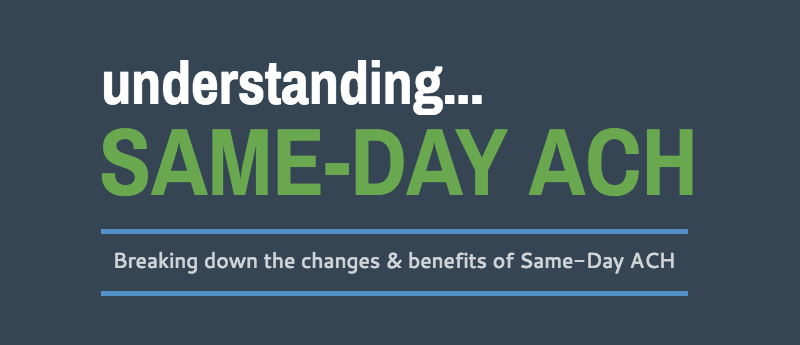
It’s said that time is money—business is expected to move fast and you would expect your money to keep up. However, whether you realize it or not, the U.S. banking infrastructure does not move as fast as what you would imagine in a world where we can get deliveries within 24 hours. When we can get a giant package delivered almost within the same day, why can’t bank transfers do the same?
However, changes are coming. Soon, businesses and consumers will have the ability to access bank transfers that occur “same day”. But first, some background...
You are a business, a merchant. You move money in and out and around every day. What you may not realize is that every time you make a transaction that goes to or from a bank account, you’re using the ACH network.
What’s the ACH network?
In short, the ACH network is the “rails” connecting all U.S. bank accounts and financial institutions. Using ACH, money moves between bank accounts. Every time you pay for your utilities via your bank account and routing number (rather than your credit card information), you’re using the ACH network.
Today, an ACH transfer takes about 2-4 business days. The reason there is this delay is because the ACH network relies on the manual process of submitting a digital file once a day (i.e. a batch of the individual credit card payments, direct deposits, utility bill, etc.) at a financial institution. There is also a delay imposed from the banks so they can ensure that the funds coming from one bank account will in fact be in that bank account, etc.
When time is money, this is a long time to wait for money to clear into your bank account. NACHA, the managers of the ACH network have adopted a rule allowing for Same-Day ACH to improve the speed at which ACH transactions occur.
Understanding Same-Day ACH
Same-Day ACH is a new rule that allows for payments to occur within a much shorter time frame than before. NACHA—the managers of the ACH network—have implemented this rule to match the expectations of the market so money moves more closely to the speed of business.
Same-Day ACH doesn’t introduce any new technology into the process, but rather improves how the process is running. Remember that batch file we mentioned earlier? Same-Day ACH adds two more windows of submission to that file. So instead of that file getting submitted once, it will get submitted multiple times each day—so funds will get on their way quicker than before.
All transactions will not be Same-Day by default. For businesses wishing to operate more quickly, get access to funds sooner, there will be a fee charged by the banks for Same-Day ACH transaction.
Those fees are still TBD, since Same-Day ACH hasn’t started rolling out to the public yet. NACHA has required banks to implement Same-Day ACH in three phases.
Phase 1 – (for payouts): Ability to receive and process Same-Day credits becomes mandatory, and additional processing windows are added. The two processing windows are at 10:30AM ET and 2:45PM ET, with new settlement times at 1:00PM and 5:00PM ET.
Phase 2 – (payout and collect payments): Ability to receive and process Same-Day debits—in addition to credits—becomes mandatory.
Phase 3 – (a new settlement window): Must make Same Day ACH funds sent before the cut-off window available to the payee by end of business on the same day.
The way to best be prepared for Same-Day ACH, is to make sure you understand potential benefits and uses….
Same-Day ACH Benefits to Business
Leveraging the ACH network to power your business payments can prove cost effective and more practical than relying on credit cards alone. For example, if you’re running a marketplace like Etsy or Jane.com, it’s most efficient to pay out to your vendors using the ACH network. If you were able to have those payouts to vendors in just 1-2 business days rather than the standard 3-4 business days, you would not only have a more efficient operation, but you would also have happier customers who get paid speedily.
Certainty of payments: Same-Day ACH also offers the benefit of efficiency and time savings. For your accounting department, they won’t have to worry about waiting on money to come in to accounts payable.
Improved control with payroll: With Same-Day, since you’re not waiting the standard length of time for direct deposits, if you made an accounting mistake in payroll (an added zero or an incomplete file), then you could more quickly reconcile the issue.
Faster payouts for the gig, on-demand economy: Even with the flexibility in schedule offered by these roles, unfortunately that doesn’t mean your providers get timely payment. With Same-Day this turnaround time could be reduced and payouts get delivered quicker.
Consistency from on-time payment: If you initiate an ACH payment ON its due-date, that payment will be late since you’re waiting on it to clear for a few days. Same-Day ACH payments provide improved flexibility and certainty.
Since Same-Day ACH has yet to be released, the question remains how those banks offering up the service will enable its use; how will banks and financial institutions provide Same-Day ACH and what will it cost to use Same-Day? Questions will surface, but one thing will remain true—any step toward faster payments is a step in the right direction.





Leave a reply or comment below